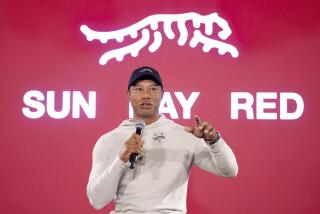Column: Don’t underestimate the power of sneakers

- Share via
I look at people who put ketchup on their eggs the same way I look at the folks who watch golf on TV. Do what you need to do. Just leave me out of it.
I’ve tried both, and in each case I quickly wanted something else.
Now, in full disclosure, I rarely put ketchup on anything, mainly soggy fries, so it’s not really about the eggs. However, when it comes to watching golf on TV, it is about the golf. I’ve always found it bland as an unsalted rice cake. That’s why I shocked myself when I found myself wanting to wear a golf shirt. But it wasn’t just any golf shirt. This one came with the flavor I’d been missing.
Olajuwon Ajanaku and Earl Cooper are the subjects of a new six-part docuseries on Hulu called “Grails,” which follows the young Black entrepreneurs as they push to bring diversity into the world of golf apparel. And they have the perfect ally: Michael Jordan, who personally selected their company, Eastside Golf, as a partner for Jordan Brand.
It was the first time an Air Jordan was made for golf, and accolades came from inside and outside of the industry. In fact, the two businessmen — both Morehouse graduates and former national golf champions — have garnered a lot of NBA and hip-hop attention, including from the likes of DJ Khaled, Fat Joe and Phoenix Suns point guard Chris Paul.
“Diddy came out of nowhere and wore the Eastside gold sweatshirt, and for him to wear that sweatshirt, it just means we’re going on the right path,” Ajanaku told me — because Sean Combs is “associated with some of the best artists in history.”
Cooper said two things have been really eye opening during this experience: seeing the interest from people who don’t care about golf and learning about the variety of people who do. They found that rapper Travis Scott plays. “We met him at a golf outing he had in Houston,” Cooper said. “The love from Victor Cruz, CC Sabathia … it’s been incredible.
“One person isn’t going to change it, but collectively we can encourage all the leaders of the golf industry to see and look at us.”
I guess here is where I should mention Tiger Woods and what didn’t happen to the sport when he came along. But it’s far more productive to shine a light on what did change.
True: After Tiger blazed a trail, there was no parade of Black Americans rising through the ranks to take on the predominantly white world of golf. There’s no Sloane Stephens or Coco Gauff, who are rising in tennis in the footsteps of the Williams sisters. In golf, there’s Tiger, just as it had been since he won his first Masters in 1997.
But there’s more to the story. Because there was Tiger Woods, Black professional athletes like Jordan had a peer of color in the sport. As more NBA players took up golf, their peers in hip-hop and other industries took notice. So while Woods may not have been a catalyst of change for the elite levels of the game — a lot of that has to do with the fact he didn’t want to be — he did connect more people to the sport. Without Tiger, a Black-owned brand like Eastside Golf wouldn’t have ended up in a partnership with Jordan and Nike.
“He knocked down the doors, and we picked up where he left off,” Cooper said. “When Tiger came on the scene, I felt like it let some of the leaders off the hook: ‘We don’t have a diversity problem; the best golfer in the world is Black.’ There’s been billions going into junior golf since Tiger, but you still don’t see the diversity.”
While Tiger showed it was possible, Cooper said, “we want to show it’s possible for a lot more people.”
Progressives say representation matters a lot in everyday discourse, and it does. But I think we sometimes overlook why. As Ajanaku explained, golf can exclude because of the culture built around it. Wealth and exclusivity are hallmarks. Until 1961 — the year the PGA stopped banning Black people — whiteness was another hallmark. Lifting the ban didn’t exactly open the gates.
The Masters went another 14 years before inviting a Black golfer. Rules and laws change slowly. The ecosystem built around rules and laws changes even more slowly.
That’s why representation matters. Seeing diversity not only indicates progress but also inspires others to continue the progress.
And you know what? Something as seemingly superficial as the marketing of clothing matters too. Before you roll your eyes, consider what Hannah Storm, who directed the documentary series, said: “The rules about what you’re supposed to wear and look like can be a barrier to access.
“We want young persons of color to be into golf, and fashion is one of the barriers,” said Storm, a former colleague and a friend of mine. “People should feel comfortable and not feel like they have to put on a costume. These guys said you could go out and hit some balls and still gonna look fly. You don’t have to jump into some world and try to fit in not dressed the way you normally would.”
Hey, men and women use the same razors, but one is marketed in pink and the other black. Consumers want to be able to see themselves using a particular product. When I encountered the Eastside Golf line, and the imagery that reflected my cultural sensibilities, I saw myself actually wanting to wear a certain kind of golf shirt and golf shoes.
The series gives an in-depth look into how these two men look to not only expand their brand but also continue to correct an intentional wrong in the sport.
“The most important piece in all of this is representation,” Cooper said. “It shows you can truly look however you want. That the sport is really working toward inclusion.”
More to Read
A cure for the common opinion
Get thought-provoking perspectives with our weekly newsletter.
You may occasionally receive promotional content from the Los Angeles Times.











